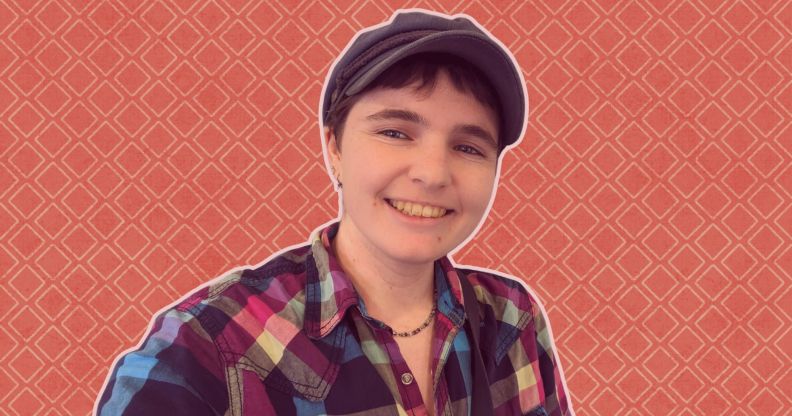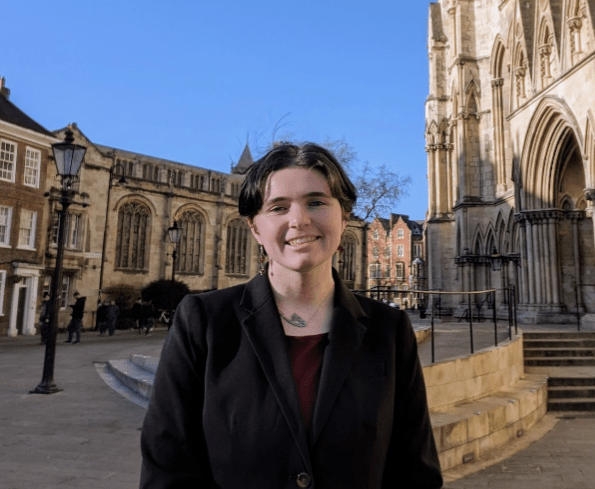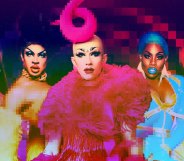‘How coming out as non-binary helped me realise I was a lesbian’

Anna Thompson is a volunteer at the LGBTQ+ Charity Just Like Us. (Anna Thompson/PinkNews)
There’s no one thing that makes someone realise they are a lesbian, but I would never have thought that for me, it would have been when I discovered I was non-binary.
I never really experienced crushes when I was growing up. As I regularly share when telling my story as a volunteer with Just Like Us, I was always the most adamantly anti-romance. It wasn’t something I related to, and really, cats, board games, and music were much more interesting to me. I spent my lunch breaks talking about school and playing chess, making all efforts to avoid any conversation about who wanted to date who.
For a couple years though, it seemed like every time I talked to a boy in my class, I was immediately assumed to be interested in dating him. And for a bit, I did actually believe it, that clearly my desire for friendship of any level of depth had to mean a romantic interest.
The worlds of platonic and romantic relationships swirled around my brain as I tried to interpret my own feelings, sometimes getting caught up in the mess of it all. Once or twice, I would get as far as being labelled someone’s “girlfriend”, and the second that happened, I would feel sick and immediately break apart the relationship.

When I came across the term “asexual” during secondary school, I knew immediately that it was a word that resonated with me. I read online about the experiences of other asexual people and felt this commonality, a sense of community. Soon enough I was finding garlic bread and cake memes everywhere, and feeling mostly comfortable and confident in who I was.
Coming out as asexual thankfully ended the discussions of who I might want to date, although it did lead to awkward conversations with relatives about whether I would get married or have a family (which is especially uncomfortable as someone holding the family role of “eldest daughter”).
After school, I went to university in the US. Though in secondary school I may have known a few LGBTQ+ people, and may have even been assumed to be “gay” thanks to my androgynous clothing and hairstyles, during my undergrad I got to know a diverse group of people, covering a wide range of the LGBTQ+ spectrum.
Once in this environment that to me felt safer and more inclusive, I found myself looking back on my secondary school years with a different perspective. I was fairly confident that I hadn’t been romantically attracted to any of the guys I managed to convince myself I was, but a few close friendships with girls came to mind from a new light. I felt sure about being asexual, but perhaps some of those female friendships were a bit closer to romantic interest than I thought?
Inspired by my hunch that I could perhaps be a lesbian, and understanding the word to mean “a woman attracted to women”, I turned to social media. I found “aesthetic lesbian” Instagram accounts and sapphic couples chatting about their experiences on YouTube. I really, really wanted to relate to it, but found I just couldn’t. It was around this time that I discovered I was non-binary.
I had always tried to present as androgynous, and had funny feelings of joy, which I now know were gender euphoria, from a few photos of me in which I looked especially gender-ambiguous. Being around other non-binary people and learning about their experiences helped me reflect on my own, and realise this piece I had been missing. I also discovered that there were non-binary people, like me, who were not attracted to men, and identified with the label of lesbian.
While we didn’t meet the definition of women, our rejection of femininity as it is assigned by a society in which women are expected to date men, we actually had a lot in common with cisgender lesbians.
Finally, all of the pieces slotted together. I was able to take on the new labels of non-binary and lesbian, and hold on to the label of asexual. I was free to imagine love and relationships how I wanted to. I may not dream of being someone’s wife or girlfriend, but I could recognise my feelings much more freely. While still not too much of a romantic, I enjoy being with my current girlfriend as her partner, and feeling free to be myself in all that it means
By rejecting the womanhood assigned to me and choosing my own path as both non-binary and asexual, I have found my way to the lesbian community as we all find our own paths in this heteronormative world together.
Anna volunteers as an ambassador for Just Like Us, the LGBT+ young people’s charity. LGBT+ and aged 18 to 25? Sign up here!
How did this story make you feel?

